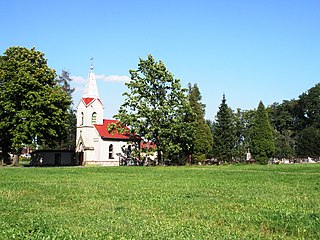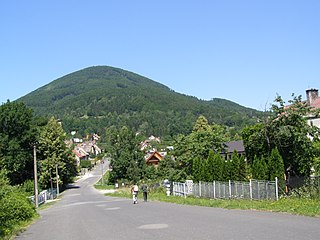
Frýdek-Místek is a city in the Moravian-Silesian Region of the Czech Republic. It has about 54,000 inhabitants. The historic centres of both Frýdek and Místek are well preserved and are protected by law as two urban monument zones.

Návsí is a municipality and village in Frýdek-Místek District in the Moravian-Silesian Region of the Czech Republic. It has about 3,900 inhabitants. The municipality has a significant Polish minority.

Dobrá is a municipality and village in Frýdek-Místek District in the Moravian-Silesian Region of the Czech Republic. It has about 3,200 inhabitants.

Sviadnov is a municipality and village in the Frýdek-Místek District in the Moravian-Silesian Region of the Czech Republic. It has about 2,200 inhabitants.

Frýdlant nad Ostravicí is a town in Frýdek-Místek District in the Moravian-Silesian Region of the Czech Republic. It has about 9,900 inhabitants.

Frýdek-Místek District is a district in the Moravian-Silesian Region of the Czech Republic. Its capital is the city of Frýdek-Místek.

Komorní Lhotka is a municipality and village in Frýdek-Místek District in the Moravian-Silesian Region of the Czech Republic. It has about 1,500 inhabitants. The municipality has a significant Polish minority. The folk architecture in the village is well preserved and is protected by law as a village monument zone.

Smilovice is a municipality and village in Frýdek-Místek District in the Moravian-Silesian Region of the Czech Republic. It has about 900 inhabitants. Former Prime Minister of Poland and former president of the European Parliament Jerzy Buzek was born here. The municipality has a significant Polish minority.

Janovice is a municipality and village in Frýdek-Místek District in the Moravian-Silesian Region of the Czech Republic. It has about 2,000 inhabitants.

Ostrava-City District is a district in the Moravian-Silesian Region of the Czech Republic. Its capital is the city of Ostrava.

Kunčice pod Ondřejníkem is a municipality and village in Frýdek-Místek District in the Moravian-Silesian Region of the Czech Republic. It has about 2,500 inhabitants.

Malenovice is a municipality and village in Frýdek-Místek District in the Moravian-Silesian Region of the Czech Republic. It has about 800 inhabitants.

Žermanice is a municipality and village in Frýdek-Místek District in the Moravian-Silesian Region of the Czech Republic. It has about 400 inhabitants.

Pazderna is a municipality and village in Frýdek-Místek District in the Moravian-Silesian Region of the Czech Republic. It has about 400 inhabitants.

Raškovice is a municipality and village in Frýdek-Místek District in the Moravian-Silesian Region of the Czech Republic. It has about 2,100 inhabitants.
Krásná is a municipality and village in Frýdek-Místek District in the Moravian-Silesian Region of the Czech Republic. It has about 700 inhabitants.

Pražmo is a municipality and village in Frýdek-Místek District in the Moravian-Silesian Region of the Czech Republic. It has about 900 inhabitants.

Staré Město is a municipality and village in Frýdek-Místek District in the Moravian-Silesian Region of the Czech Republic. It has about 1,500 inhabitants.

Paskov is a town in Frýdek-Místek District in the Moravian-Silesian Region of the Czech Republic. It has about 3,900 inhabitants.

Fryčovice is a municipality and village in Frýdek-Místek District in the Moravian-Silesian Region of the Czech Republic. It has about 2,400 inhabitants.
























